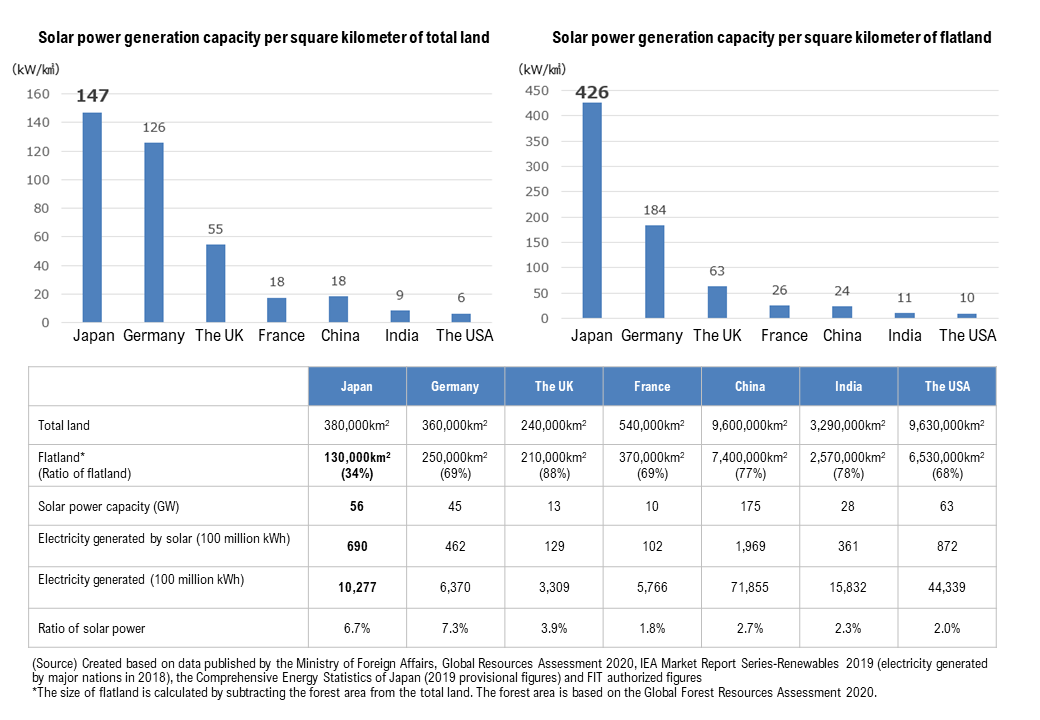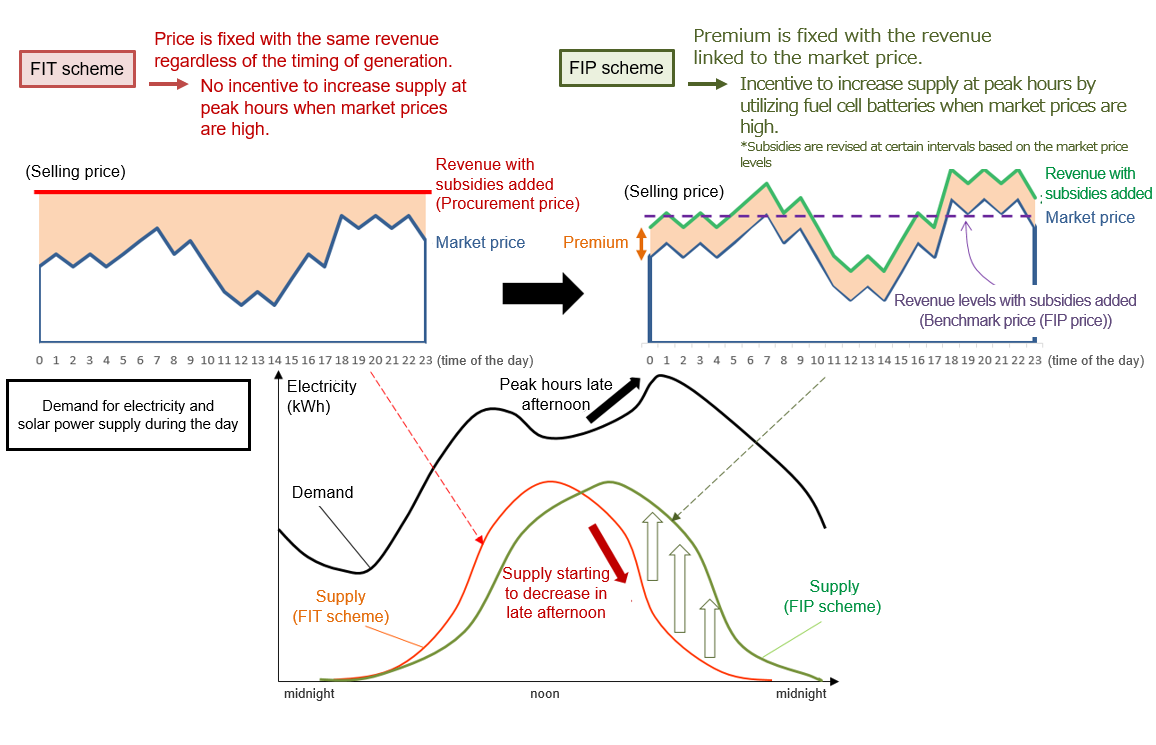Here’s more about the 6th Strategic Energy Plan
Renewable energy expanding with cost reduction while promoting acceptance of local communities
(in provisional translation)
(English ver.) 2022-11-25
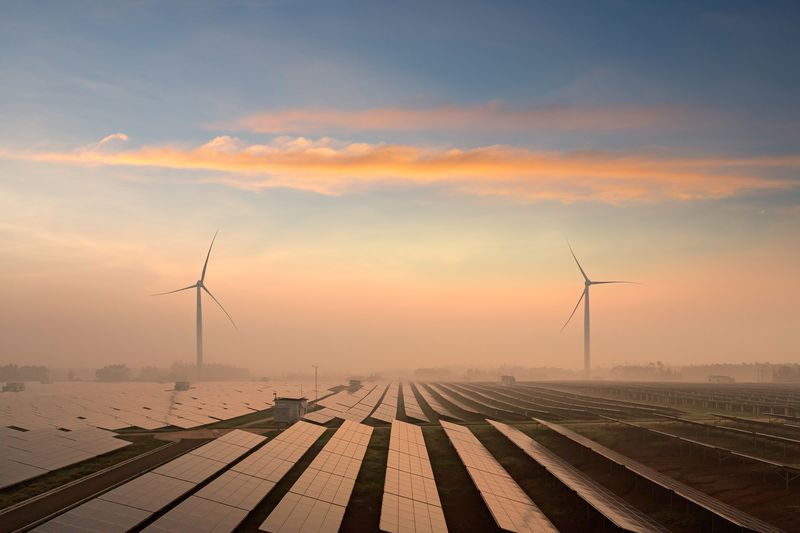
On October 22, 2021, the Government of Japan published the 6th Strategic Energy Plan to show the direction of Japan’s energy policy. It explains our climate-related efforts to overcome challenges toward achieving carbon neutrality by 2050. It also covers policies to solve various issues in relation to the energy supply/demand structure of Japan. From the many topics covered by the 6th Strategic Energy Plan, this article focuses on renewable energy which is positioned as a main source of electric power generation in the future.
Expanding the introduction of renewable energy as a “main source of power generation”
Renewable energy emits no CO2 and can be produced domestically, which makes it a promising and important source of energy contributing to not only environmental protection but also energy security. It was in the 5th Strategic Energy Plan published in 2018 that a policy was explicitly stated for making renewable energy a main source of power generation. In recent years, the introduction of renewable energy has been increasing substantially with its generation costs quickly reduced globally. It has now become cost-competitive with other sources of power generation.
Japan’s percentage of electricity generated by renewables in total power generation increased from 10% in FY2011 to 18% in FY2019 thanks to the Feed-in Tariff (FIT) scheme that was introduced in July 2012. As a result of utilizing the limited land, the solar power generation capacity per square kilometer of Japan’s total land as well as its flatland ranks 1st among major nations.
Electricity generated by renewable energy in Japan
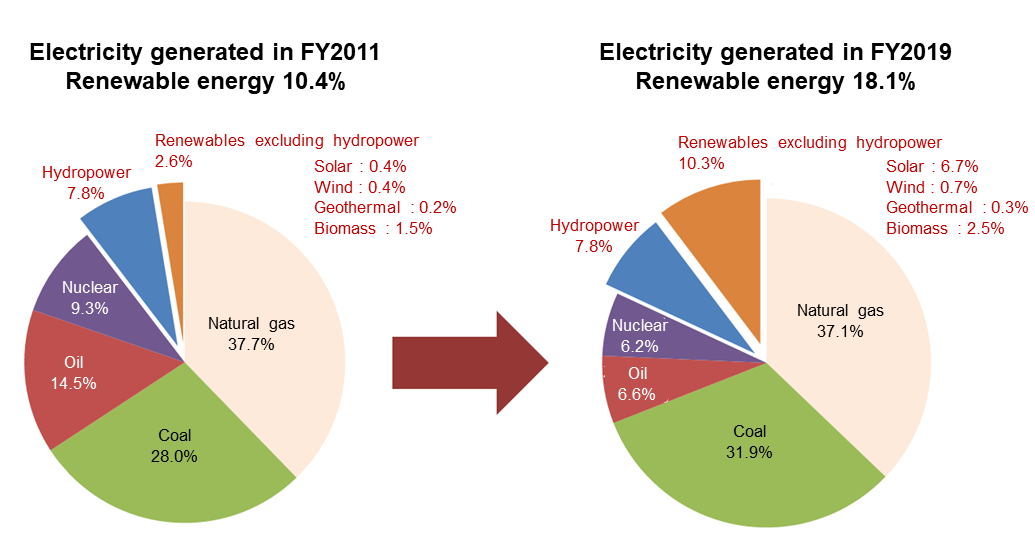
(Source) Created by ANRE based on the Comprehensive Energy Statistics of Japan
The total generation capacity by renewable energy in Japan ranks 6th in the world with electricity generated by renewables having tripled since 2012.
Renewable energy power generation capacity among major nations
(2020 actual figures)
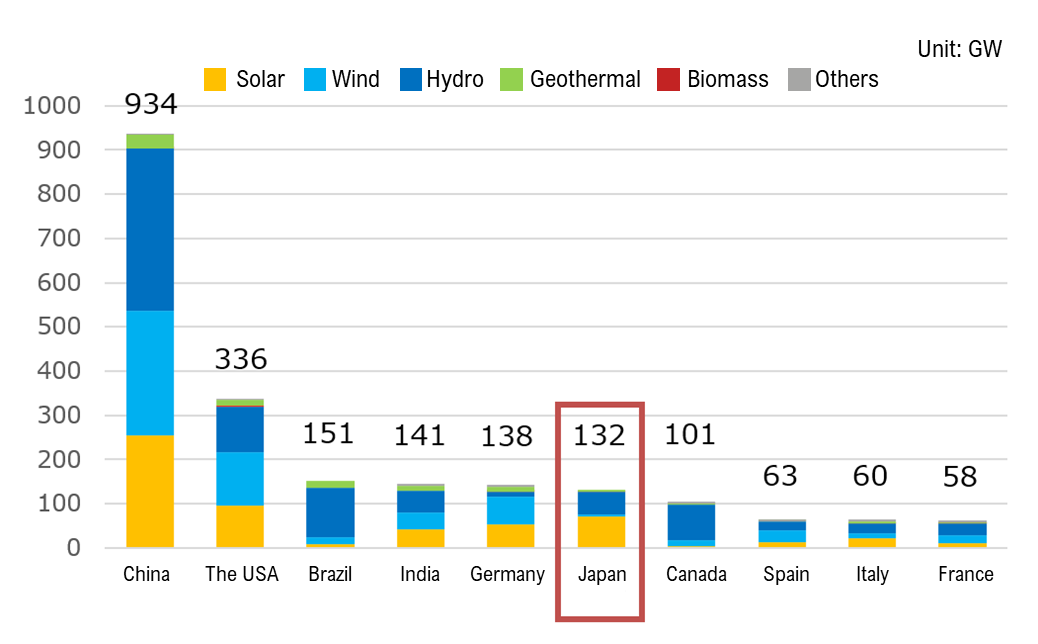
(Source) Created by ANRE based on Renewables 2021 published by the IEA
Electricity generated by renewables (excluding hydropower)
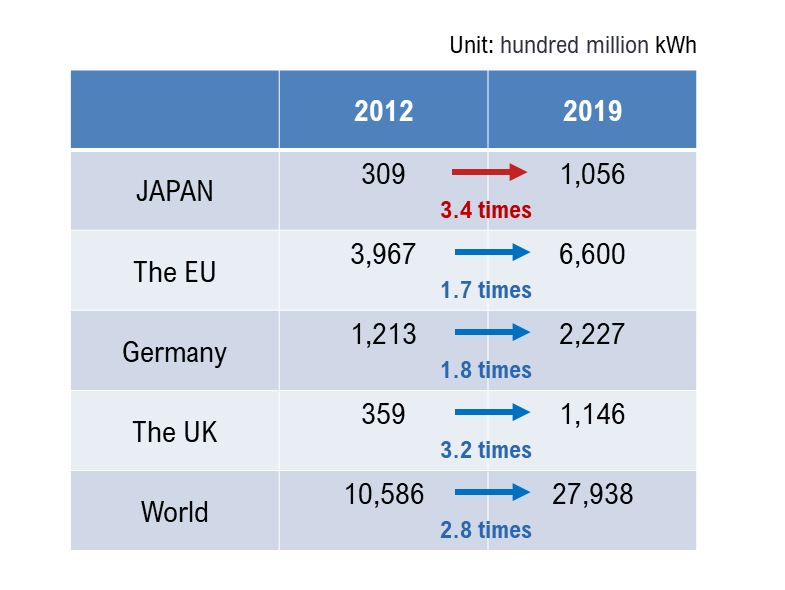
(Source) Created by ANRE based on the IEA database
Aiming to overcome the four challenges
Against the backdrop described above, the latest Strategic Energy Plan stipulates the following:
-
 On the major premise of S + 3E, a maximum introduction of renewable energy will be pursued. To this end, efforts will be made toward making renewable energy a major portion of the power mix while lowering the burden on the people and promoting acceptance by local communities.
On the major premise of S + 3E, a maximum introduction of renewable energy will be pursued. To this end, efforts will be made toward making renewable energy a major portion of the power mix while lowering the burden on the people and promoting acceptance by local communities.
More specifically, the following four challenges need to be overcome:
1. Cost reduction and independence from the FIT scheme
2. Coexistence with local communities and strengthening of the business discipline
3. Addressing grid constraints
4. Measures based on the characteristics of each power source
Our policy is to expand renewable energy while securing safety across the entire power system, with the above four items placed at the core.
Let us look at 1. Cost reduction, and 2. Coexistence with local communities.
Progress in the integration of renewable energy into the electricity market thanks to the FIT scheme
Although the costs of renewable energy power generation have been decreasing steadily, they are still high by international standards. The purchase costs paid by power utilities based on the FIT scheme to expand renewables have been partially passed onto consumers as a surcharge, which is expected to amount to 2.7 trillion yen in FY2021. It is necessary to expand the introduction of renewable energy while suppressing the financial burden on the people.
Changes in solar power generation costs in Japan and the world
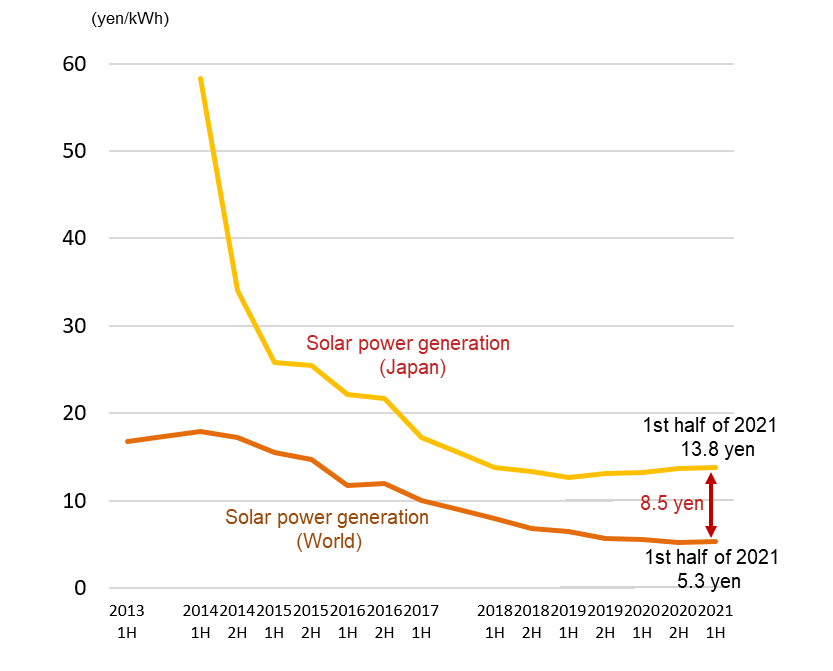
(Source) Created by ANRE based on Bloomberg NEF data. Calculated at the exchange rate of 110 yen to the US dollar.
We will make efforts to reduce costs of renewable energy to levels competitive with other power sources as early as possible, which will accelerate self-reliant introduction. More specifically, tenders will be utilized with medium-to long-term target prices established, and support will be provided for research and development toward reducing costs.
We will also advance the integration of renewable energy into the electricity market through the FIP (Feed-in-Premium) scheme whereby power generating businesses sell electricity in the wholesale market or through off-market private transactions with electricity retailers. In the FIP scheme, a certain premium, which is calculated based on the market prices, will be granted to the power generating businesses. Through these efforts, cost reduction will be achieved across the entire power system.
Inoperative projects also cause problems. They maintain a high procurement price (purchase price of renewables) that was granted at the time of FIT authorization, but do not start operation for a long time. The procurement prices for those projects do not reflect annually decreasing costs of solar panels, which will provide the operators with truly excessive profits when the projects start operation, potentially imposing a heavy burden on consumers in the future. Furthermore, even if those projects remain inoperative, they will continue to hold a certain amount of grid capacity, which was granted at the time of FIT authorization. This will inhibit new power generating businesses from utilizing the power grid, causing inefficiency in the existing power grid.
From April 2022, a system will be in place through the revision to the relevant Act* whereby the FIT authorization granted to those inoperative projects can be reversed. We will execute this system properly to accelerate a smooth introduction of renewable energy while suppressing the burden on the people.
* Act on Special Measures Concerning Procurement of Electricity from Renewable Energy Sources by Electricity Utilities
Enhancing safety measures and business transparency to promote acceptance by local communities
In order to expand the introduction of renewable energy, it is essential to promote acceptance by local communities where the facilities are constructed. Power generating projects must be conducted in a proper, trustworthy manner from start to finish.
The relevant Act (The Act on Special Measures Concerning Procurement of Electricity from Renewable Energy Sources by Electricity Utilities) that was revised in 2016 stipulates compliance with all related laws and ordinances as authorization criteria. The Act also states that proper communication with local people must be established on a best endeavor basis. However, as a large number of companies are rushing into the renewable energy power generation business, concerns are still arising in local communities over issues such as safety, disaster prevention, impact on the environment and landscapes, and equipment disposal at the end of the project life. The following efforts will be made to respond to these concerns.
Promoting acceptance by local communities
Business details such as the operator, venue and project descriptions must be announced beforehand. Otherwise, acceptance by the local community cannot be obtained. Information such as the name of the operator and capacity of the equipment have been made available on METI’s website since 2016. From FY2022, more information such as the operating status of generation facilities will also be published to ensure transparency.
There have been an increasing number of cases where local municipalities establish ordinances and guidelines to protect public interests such as the environment and landscapes since the FIT scheme started. Businesses must comply with these ordinances and guidelines in accordance with the relevant Act. A database will be created compiling and analyzing ordinances nationwide, which will help municipalities formulate their own ordinances based on their specific situations. It will also aim to share case examples of efforts made by municipalities.
Ensuring proper project implementation from start to finish
To ensure that businesses properly carry out the projects from start to finish, since April 2017 it has been a statutory mandate for authorized project operators to display a signboard and construct a fence at the site. However, there are some operators that have not met this requirement, so a stricter system will be put in place.
In order to reduce risks of the equipment being illegally abandoned or thrown away at the end of project life, disposal costs are, as a general rule, to be withheld and reserved in an external account. This applies to all types of solar power generation equipment with a capacity of 10 kilowatts or more for business purposes.
Ensuring safety
In recent years, natural disasters such as typhoons and torrential rains have occurred more frequently and devastatingly due to climate change. Against this backdrop, the society is becoming more concerned about the safety of renewable energy generation equipment. Therefore, it is essential to implement solid safety measures.
Particularly, there are many solar power generation projects underway, and the number of accidents affecting them is increasing. Specific technical standards were established for solar power equipment in April 2021, which include measures to prevent landslides on sloping land.
Small generation equipment has so far been exempted from accident reports. Going forward, there will be an obligation to report accidents for better safety management for all the equipment, regardless of its size.
Division in charge
About the article
New and Renewable Energy Promotion Office, Energy Efficiency and Renewable Energy Department, ANRE
About Special Contents
Research and Public Relations Office, Commissioner’s Secretariat, ANRE
![]() The original Japanese text of this article; Click here
The original Japanese text of this article; Click here
